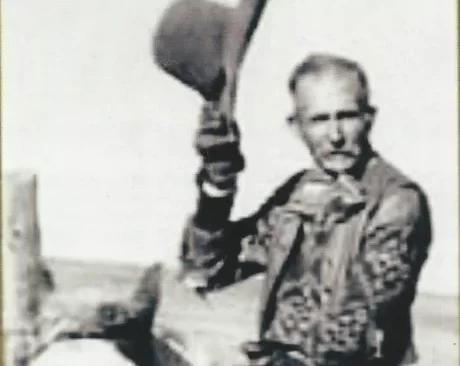Few humans inhabit the verdant hills and valleys of the horse-rich Cayuse Ranch in northeastern Wyoming. Yet, in mid-June of 2007 cars, vans, pickups, campers and horse trailers, driven and towed by some 200 Spanish Mustang enthusiasts from across the United States and Canada stirred up a dust storm getting to that holy ground where the Spanish Mustang is preserved and flourishes. The occasion was a Golden Anniversary celebration for the Spanish Mustang Registry. SMR will celebrate its 60th anniversary next summer, but it is only the tip of the iceberg in Bob Brislawn’s amazing story.
Son of Irish immigrants who farmed wheat with horses near Sprague, Washington, Bob hit the survey trail as soon as he graduated from high school. Starting on foot, for the North Coast Railroad, and continuing from 1911 through 30 seasons with the United States Geological Survey, he covered the rugged Western United States with horses. That’s how he met the Mustang, and the reason he spent the rest of his life making sure they did not vanish through crossbreeding.
Spanish Mustangs are not the only rare equines Bob helped save – as he was with Army Expeditionary Forces during World War I and assisted in the rescue of the historically purebred Lippizans of the Spanish Riding School in Austria. Those were happier moments than the Battle of Verdun flashbacks in which he could close his eyes and see the soldiers who were cold, bloody and hungry.
Bob and his dad, Rary Fir Brislawn, filed homesteads on the Short Prong of Prairie Creek near Oshoto, Wyoming in 1913, and Bob’s homestead house is still there. They put up prairie hay and Bob’s life work was ranching, raising and caring for cattle and horses, along with his five children which he raised alone after his wife, Gennevieve, died in 1942.
Like all ranchers, Bob trailed cattle long distances, and in the fall shipped on the railroad to the big Omaha market; sometimes leaving the kids to tend the ranch as he rode the caboose back there with other cattlemen to sell his stock. Whenever he could, he earned extra money with survey crews – furnishing horses and packing in 15 states across America’s most rugged environs. He saw the unusual mettle of the Mustang and also discovered their endangerment as the U. S. Government destroyed herds belonging to some still-unsettled bands of Natives.
Realizing the true Marismenyo horse the Conquistadors introduced to America would be lost, Bob and his family searched from Canada into Mexico, Utah, Montana, Oklahoma, Texas and many other places to find, buy and ride or trail home to Cayuse Ranch as many of the pure blood Spanish barb horses as possible. A few at a time, from place to place, they collected a nucleus that has survived to save the breed.
Through the Wild Horse Research Farm in California, scientific data proved the Mustang structurally unique in many ways, including the number of ribs and vertebrae and the shape of the cannon bone. Bob was determined to keep that DNA pure, and once said of his work, “The preservation of this heroic and historical monument to our nation’s past – and to the ages and lands that came before – took precedence.”
As Bob’s son Neil UiBreaslain (Oh-Breeze-Lane) recorded in Bob’s Biography THE WAY OF AN IRISH HORSEMAN, “Dr. Lawrence P. Richards, zoologist, at Pocatello, Idaho . . . made a three hundred page study of the Indian or Spanish horse in the USA – their conformation, bone structure and behavior. With Neil naming the organization, and Dipper drawing up the papers and filing them with Cheyenne, it came about that I, together with my kids and . . . friends . . . incorporated the Spanish Mustang Registry (SMR) at Sundance, Wyoming, June 17, 1957, for the ‘purpose of preservation of the Spanish (Barb) Mustang’”
Although Bob once had to stand his ground against gunmen who wanted his land, he persevered and became a rich icon of Wyoming range history.


